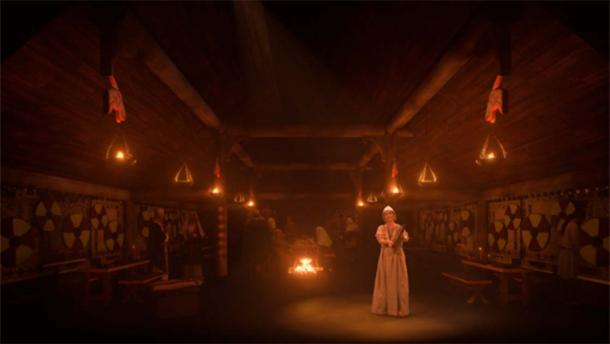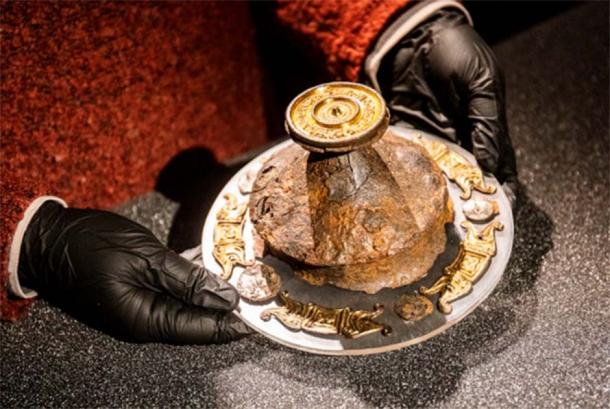
Ad Gefrin Museum: A Must-Visit Destination for History Buffs and Whisky Lovers
The little-known history of a Northumbrian Anglo-Saxon royal court is to be unveiled with the opening of Ad Gefrin Anglo-Saxon Museum and Whisky Distillery in Wooler, Northumberland, England on March 25, 2023. The museum showcases Anglo-Saxon archaeological treasures that were found on the site of a 7th-century palace known as Ad Gefrin, which was the stage for key events in early northern English history. The collection includes jewelry, ceramics, and weaponry found across the north-east and other areas of England. An immersive film experience recreates the court’s great hall and brings its occupants to life.

AV Experience, Ad Gefrin Great Hall, Stef Connor as Leofwynn the Bard. (Freak Films/ Ad Gefrin)
A Historic Royal and Religious Location
Ad Gefrin was rebuilt by Anglo-Saxon King Edwin in 616 AD. He came from southern England to take his position as the first king of a united Northumbria, which then stretched between the Humber and the Forth estuaries.
Two subsequent kings, Oswald and Oswiu, also ruled from Ad Gefrin. It was one of a handful of royal residences in a vast northern kingdom that blended Britons and Anglo-Saxon settlers. For a century, the palace became the stage for key events in early northern English history and is central to our understanding of the history of religion in the British Isles.
It was the location where the Venerable Bede tells us mass conversions to Christianity took place, and that Queen Æthelburh’s bishop, Paulinus, spent 36 days baptizing people ‘from morning to night’ from across the region in the River Glen.
All the kings of Anglo-Saxon England were Christians by this time, at least outwardly, through the gradual change of religion that has started with the Roman invasion.
- How Anglo-Saxon England Made the Radical Change to Christianity
- Vikings Didn’t Just Murder Monks and Pillage Monasteries – They Helped Spread Christianity Too
The site was discovered in 1949 at Yeavering in the Cheviot Hills, a few miles from where the new museum has been constructed, and is considered to be one of the major archaeological finds of the 20th century.
Pioneering the use of aerial photography in archaeological research, archaeologist Kenneth St Joseph took off from a nearby airfield in the early 1950s, on a flight that led to the palace site being found.
Upon excavation in 1953, the site was found to include several large halls, and a wooden grandstand, which was a unique feature for the time in Western Europe. This suggests that the nature of this northern kingdom was distinct from the rest of England at the time, and more like that of Scandinavia and Northern Europe.
Research on the site continues, led by Professor Sarah Semple at the archaeology department at Durham University, and modern techniques have shown that there are further buildings yet to be excavated.
- The Saxon Conquest of Europe, and a Christian Conquest of Saxons
- The Anglo-Saxon Conquerors: Creators of Medieval England
An Anglo-Saxon Northern England Revealed
The collection on display at Ad Gefrin includes not only items found on the site of the palace, but also jewelry, ceramics, and weaponry found across the north-east and other areas of England. Together, they illuminate the richness of life within the Anglo-Saxon court through intricate craftsmanship and artistry.
Some of the highlights include the Castle Eden claw beaker (top image), found in Durham in 1775, a pseudo-Roman coin pendant, and a silver wrist clasp.
A replica of the Franks Casket, a small box made of whale-bone depicting scenes from Roman, Jewish, Christian and Germanic tradition, has been loaned by the British Museum.

Replica of Franks Casket in Ad Gefrin museum (Courtesy of The British Museum/Ad Gefrin)
Another incredible item that is on loan from The Shakespeare Birthplace Trust is the Bidford shield boss, shown below.

Shield Boss courtesy of The Shakespeare Birthplace Trust arrives at Ad Gefrin Museum (Ad Gefrin)
New Life Brought to 7th-Century Palace Site
Ad Gefrin’s unique business model has established a symbiotic relationship between the historic cultural offer and the whisky distillery. Visitors to the museum will secure the business's success in the early years, but the international commercial success of Ad Gefrin Single Malt Whisky will ultimately offer financial security for the long term. Both the museum and distillery take their inspiration and values from the timeless hospitality of the Anglo-Saxon royal court, perhaps creating a new golden age for Northumbria.

The site is also home to the Ad Gefrin whisky distillery. (Ad Gefrin)
Chris Ferguson, Director of Visitor Experience, said, “I am incredibly proud that we’ve been able to work with so many people to bring the story of the ancient kingdom of Northumbria to life for people today; and to do so with the incredible collection from Yeavering and outstanding loans from national collections. The finished Museum is a testament to the power, splendor, and extraordinary culture of Northumbria’s Golden Age.”
Top image: Left, The Castle Eden Claw beaker, courtesy of the British Museum. Right, The atrium roof at Ad Gefrin Anglo-Saxon Museum & Distillery. Source: Ad Gefrin
By Gary Manners















